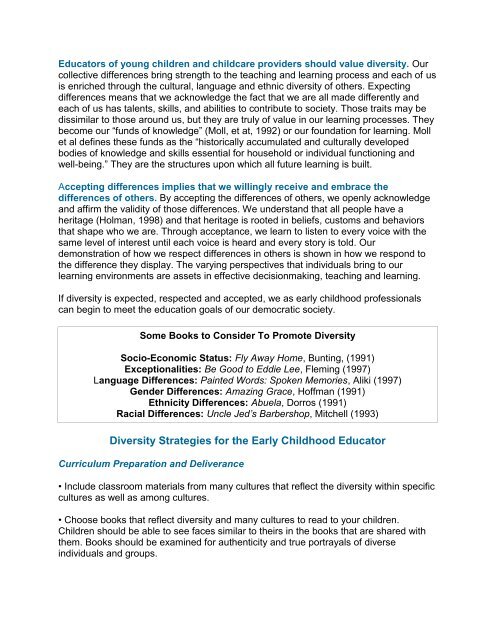Valuing Diversity for Young Children - Southern Early Childhood ...
Valuing Diversity for Young Children - Southern Early Childhood ...
Valuing Diversity for Young Children - Southern Early Childhood ...
You also want an ePaper? Increase the reach of your titles
YUMPU automatically turns print PDFs into web optimized ePapers that Google loves.
Educators of young children and childcare providers should value diversity. Our<br />
collective differences bring strength to the teaching and learning process and each of us<br />
is enriched through the cultural, language and ethnic diversity of others. Expecting<br />
differences means that we acknowledge the fact that we are all made differently and<br />
each of us has talents, skills, and abilities to contribute to society. Those traits may be<br />
dissimilar to those around us, but they are truly of value in our learning processes. They<br />
become our “funds of knowledge” (Moll, et at, 1992) or our foundation <strong>for</strong> learning. Moll<br />
et al defines these funds as the “historically accumulated and culturally developed<br />
bodies of knowledge and skills essential <strong>for</strong> household or individual functioning and<br />
well-being.” They are the structures upon which all future learning is built.<br />
Accepting differences implies that we willingly receive and embrace the<br />
differences of others. By accepting the differences of others, we openly acknowledge<br />
and affirm the validity of those differences. We understand that all people have a<br />
heritage (Holman, 1998) and that heritage is rooted in beliefs, customs and behaviors<br />
that shape who we are. Through acceptance, we learn to listen to every voice with the<br />
same level of interest until each voice is heard and every story is told. Our<br />
demonstration of how we respect differences in others is shown in how we respond to<br />
the difference they display. The varying perspectives that individuals bring to our<br />
learning environments are assets in effective decisionmaking, teaching and learning.<br />
If diversity is expected, respected and accepted, we as early childhood professionals<br />
can begin to meet the education goals of our democratic society.<br />
Some Books to Consider To Promote <strong>Diversity</strong><br />
Socio-Economic Status: Fly Away Home, Bunting, (1991)<br />
Exceptionalities: Be Good to Eddie Lee, Fleming (1997)<br />
Language Differences: Painted Words: Spoken Memories, Aliki (1997)<br />
Gender Differences: Amazing Grace, Hoffman (1991)<br />
Ethnicity Differences: Abuela, Dorros (1991)<br />
Racial Differences: Uncle Jed’s Barbershop, Mitchell (1993)<br />
<strong>Diversity</strong> Strategies <strong>for</strong> the <strong>Early</strong> <strong>Childhood</strong> Educator<br />
Curriculum Preparation and Deliverance<br />
• Include classroom materials from many cultures that reflect the diversity within specific<br />
cultures as well as among cultures.<br />
• Choose books that reflect diversity and many cultures to read to your children.<br />
<strong>Children</strong> should be able to see faces similar to theirs in the books that are shared with<br />
them. Books should be examined <strong>for</strong> authenticity and true portrayals of diverse<br />
individuals and groups.
















